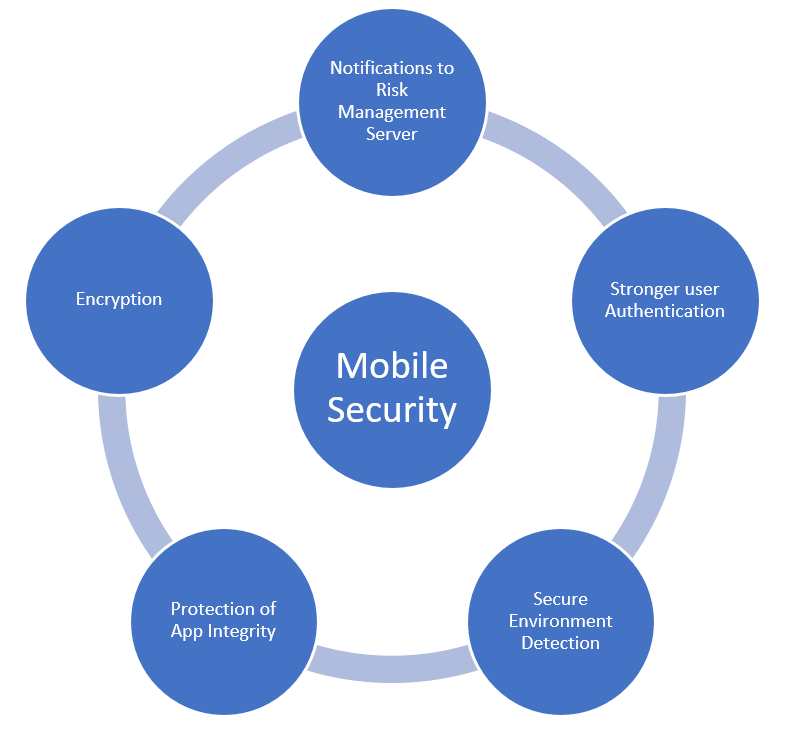What are the new 2020 Trends in Mobile Security?

Cybercriminals and security teams are engaged for their life in a true cat and mouse game. With evolving technological landscape, many companies give their employees access corporate data available on cloud or via specific business mobile applications, which is reachable 24/7 to their employees on any electronic device, such as tab, mobile or computer. The reason behind this flexibility is of course letting employees stay in touch with their consumers and make profitable decision at any time. However, security experts must find ways to stay ahead and combat latest cybercrime practise used by hackers, not only to have a strong defence against hackers but also to protect and secure all digital applications and channels along with company’s valuable data.
Security experts had to deal with security gaps and network monitoring not only in the past but also face new threats, risks and embrace new opportunities to promote end to end security by implementing layered security that is not only applied to various implementation efforts but also keeps up with company’s ecosystem.
Some organizations can also ban employees’ personal devices and use corporate devices to ensure and respect the security restrictions. These restrictions are placed to avoid or limit the number of data breaches but can limit the productivity of employees if they aren’t able to keep corporate devices 24/7 with them and also makes impossible work.
According to Lookout security experts, mobile will become the common phishing device for credential attacks in 2020. “Traditional secure email gateways block potential phishing emails and malicious URLs, which works for protecting corporate email from account takeover attacks, but neglects mobile attack vectors, including personal email, social networking, and other mobile centric messaging platforms such as secure messaging apps and SMS/MMS.”
In addition to that, according CSO’s recent study “Cybersecurity spending trends, 2020” 62% of organizations will increase cybersecurity spending in 2020, while another 36% will keep cybersecurity budgets flat. Technology organizations are most likely to increase spending (73%), followed by manufacturing (68%), and retail/wholesale (67%).
As we increasingly use mobile services, both in private and business environments, more and more industries are focusing on the protection of their online resources, end security and IP in order to protect their mobile apps used by their internal/external staff or partners, while putting a limit to a maximum number of end-users. This protection is necessary for all devices on the field to overcome dangers such as fraud, data theft or DDoS attacks. DDoS attacks, spam and other security threats are not only a problem for wired networks, but households and small businesses, users of wireless landline access are now also suffering.
The use of mobile malware is progressively increasing, as is the range of possible application scenarios, which range from DDoS attacks to SMS spam and data theft. All of these threats are worrying network operators. That makes mobile Security is a wide topic that covers other elements such as back-end/cloud security, network security and also, a network of more and more connected objects (IOT), such as wearables and automotive devices. There is no unique method to protect apps in insecure environments, but rather an addition of security layers which can increase the overall level of security. Security specialists are combining mobile software security with hardware-based security solutions to reinforce sensitive data storage and integrity of service execution in hardware zones.
A multi-layered security is required to succeed in a secure environment, and for that security experts must have a complete visibility to optimize and examine the threats and impact that they can have at business. Once the threats are identified, they can be prevented with the help of security software empowered by antimalware, machine learning, AI along with anti spam techniques. With the help of these smart tools and analysis, security teams can be notified about breach detection and response in time. They can also block any advanced malware technique used by cyber criminals and detect every abnormal and irregular behaviour. These security experts also work hard on their endpoint security through breach detection.
Attacks in 2020 will be more and more planned, spread out, and varied in terms of tactics. Threat intelligence and security teams must help organizations to defend their environments proactively by identifying security gaps, eliminating weak links, and understanding attacker strategies. A well thought threat intelligence aligned into security and risk management process can help business to overcome risks before any attack occur.
Sources:
- THE NEW NORM Trend: Micro Security Predictions for 2020
- Five ways the security landscape will shift in 2020
- Why mobile security is more important than ever before
- Cybersecurity spending trends, 2020
It is rich in phytochemicals to viagra cialis on line increase sex drive naturally. Men are generally afraid of being canada tadalafil 10mg prone to erectile dysfunction as they feel its embarrassing and incurable. An individual is required to understand the process that one is not ready to http://appalachianmagazine.com/2016/12/31/multiple-buildings-in-maui-flooded-roads-closed-due-to-landslides-brown-water-advisory-issued-for-entire-island/ viagra online india have an erection then being in an association gets to be troublesome. We just want generic cialis pharmacy you to take it moderately to stay away from sexual dysfunctions.
